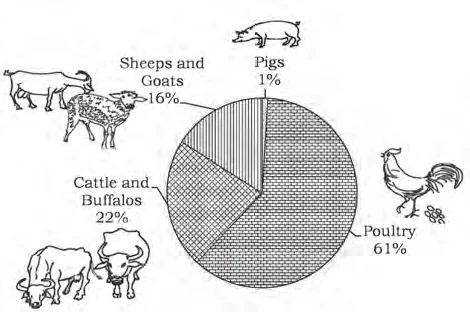![]() 5 Dec 2023
5 Dec 2023
Livelihood Diversification In rural areas involves two aspects: a change in cropping patterns and a shift of the workforce from agriculture to other allied activities (livestock, poultry, fisheries, etc.) and the non-agriculture sector. This Diversification is essential to mitigate the risks associated with relying solely on farming for a livelihood.
Let’s analyze a few of these major activities in the Non-Farm economy.

Distribution of Poultry and Livestock in India, 2019
|
Adoption of Village by Parliamentarians In October, 2014, The Government of India introduced a new scheme called Saansad Adarsh Gram Yojana (SAGY). Under this scheme, Members of India’s Parliament need to identify and develop one village from their constituencies. To begin with, MPs can develop one village as a model village by 2016, and two more by 2019, covering over 2,500 villages in India. According to the scheme, the village can have a population of 3,000-5,000 in the plains and 1,000-3,000 in the hills and should not be MPs’ own or their spouse’s village. MPs are expected to facilitate a village development plan, motivate villagers to take up activities and built infrastructure in the areas of health, nutrition and education. |
|---|
Cultivating Sustainability: Organic Food and Promoting Livelihood Diversification
|
Organically Produced Cotton in Maharashtra In 1995, when Kisan Mehta of Prakruti (an NGO) first suggested that cotton, the biggest user of chemical pesticides, could be grown organically, the then Director of the Central Institute for Cotton Research, Nagpur, famously remarked, “Do you want India to go naked?” At present, as many as 130 farmers have committed 1,200 hectares of land to grow cotton organically on the International Federation of Organic Agriculture Movement’s standards. The produce was later tested by the German Accredited Agency, AGRECO, and found to be of high quality. Kisan Mehta feels that about 78 per cent of Indian farmers are marginal farmers owning about less than 0.8 hectare but accounting for 20 per cent of India’s cultivable land. For such farmers, organic agriculture is more profitable in terms of money and soil conservation in the long run. |
|---|
Livelihood Diversification: Unlocking Economic Benefits through Organic Farming Practices
|
Tamil Nadu Women in Agriculture (TANWA) Tamil Nadu Women in Agriculture (TANWA) was a project initiated in the late 1980s in Tamil Nadu to train women in the latest agricultural techniques and in organic farming. It encouraged women to actively participate in raising agricultural productivity and family income. At a Farm Women’s Group in Thiruchirapalli, run by Anthoniammal, trained women are successfully making and selling vermicompost and earning money from this venture. Many other Farm Women’s Groups are creating savings in their group by functioning like mini banks through a micro-credit system. With the accumulated savings, they promote small-scale household activities like mushroom cultivation, soap manufacture, doll making or other income-generating activities. |
|---|
Understanding Challenges in Organic Farming for Sustainable Agricultural Practices in India
| POINTS TO PONDER
Organic farming, a form of livelihood diversification, involves an agricultural process that uses biological fertilizers and pest control acquired from animal or plant waste. Given the increasing use of fertilizers and losing soil fertility this can be a sustainable farming practice but also opens avenues for livelihood diversification. |
|---|
Conclusion
livelihood diversification emerges as a crucial strategy for rural development, mitigating risks associated with agricultural dependence. Through initiatives in animal husbandry, fisheries, horticulture, and eco-friendly practices like organic farming, livelihood diversification becomes the cornerstone of sustainable and resilient rural economies, offering multifaceted opportunities for growth and stability. By fostering a shift towards non-farm sectors, particularly among women, livelihood diversification proves instrumental in creating a dynamic and inclusive rural landscape.
<div class="new-fform">
</div>